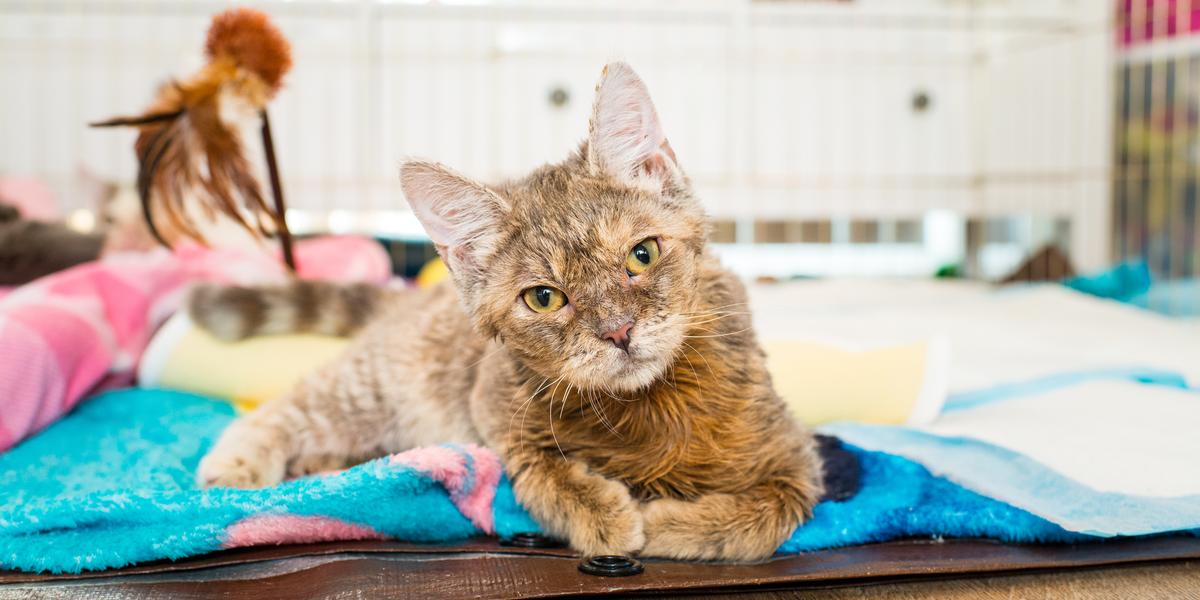
Cerebellar hypoplasia, also known as ‘wobbly cat syndrome’, is an anatomical deformity of a kitten’s brain that leads to abnormal movements and gait. This neurological disorder can affect cats and dogs, but there are different underlying reasons in different species.
Quick Overview: Cerebellar Hypoplasia in Cats
 Other Names: Wobbly cat syndrome, CH cats
Other Names: Wobbly cat syndrome, CH cats
 Common Symptoms: Poor growth, incoordination, head bobbing, muscle tremors
Common Symptoms: Poor growth, incoordination, head bobbing, muscle tremors
 Requires Ongoing Medication: No
Requires Ongoing Medication: No
 Vaccine Available: Vaccine available against feline panleukopenia, which is linked to the disease
Vaccine Available: Vaccine available against feline panleukopenia, which is linked to the disease
 Treatment Options: Environmental adjustment only
Treatment Options: Environmental adjustment only
 Home Remedies: Keep indoors, use low-sided bowls and litter trays and use non-slip flooring to help mobility
Home Remedies: Keep indoors, use low-sided bowls and litter trays and use non-slip flooring to help mobility
Cerebellar hypoplasia means that a kitten has a smaller than normal cerebellum, which is a key part of the central nervous system, located at the back of the cat’s brain. The cerebellum provides the semi-automatic control of body movements, particularly fine and delicate movements, allowing animals (and humans) to move around in a coordinated way. If the cerebellum is smaller than normal, the kitten cannot move around in a normal, smooth, coordinated way.
What Causes Cerebellar Hypoplasia in Cats?
Cerebellar hypoplasia is a congenital anomaly: the kitten is born with a smaller or otherwise imperfect cerebellum. There are a few reasons why this might happen.
- Genetic mutation: this is uncommon, but cerebellar hypoplasia can be due to an inherited or one-off genetic mutation in the womb
- Feline panleukopenia: infection of a female cat in late pregnancy, or kittens infected in the first three weeks of life with feline panleukopenia virus (feline distemper, or feline parvovirus) can stunt cerebellar development. Vaccination of pregnant cats with a live virus vaccine can also lead to development of cerebellar hypoplasia.
- Other factors in late pregnancy: the cerebellum forms during the last three weeks of gestation so any toxin, illness or agent affecting the queen in late pregnancy can affect the kittens’ development
Cerebellar hypoplasia is rare in kittens now. It used to be more common, before widespread and effective vaccination against feline panleukopenia was carried out, because of the link between this virus and the condition. There is no link to specific breeds.
Symptoms of Cerebellar Hypoplasia
Clinical signs of feline cerebellar hypoplasia are caused by a lack of fine motor skills and an inability to move around in a normal coordinated way. Signs may vary, from very mild to very severe.
Common signs include:
- A general lack of coordination
- Ataxia (loss of balance)
- Swaying instead of standing still
- Hypermetria: a jerky walk, lifting the feet too high when walking, almost like “goose stepping”
- Muscle tremors
- Feet held in wide-based stance
- Head tremors and bobbing
- Inability to suckle well, resulting in poor growth
Some kittens have other concurrent abnormalities of the brain (such as hydrocephalus) which can lead to a different and possibly confusing combination of different neurological signs.
Diagnosis of Cerebellar Hypoplasia
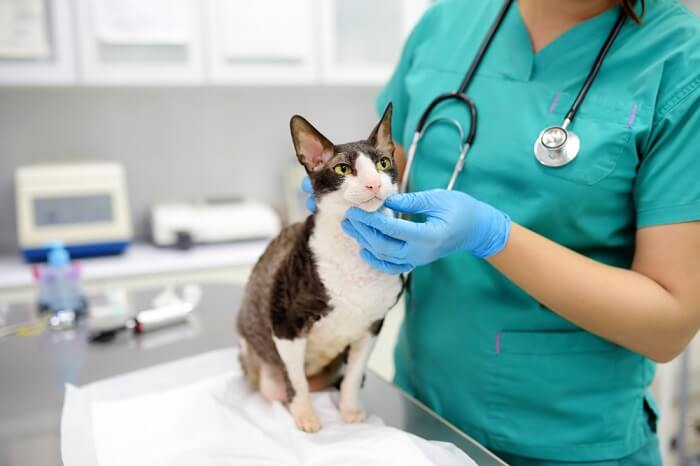
Cerebellar hypoplasia can be detected using MRI (magnetic resonance imaging) which may show that a cat has a smaller cerebellum than normal.
When a kitten shows the signs listed above, cerebellar hypoplasia may be suspected, and you need to take your kitten to your DVM veterinarian for a consultation. Your veterinarian may suspect cerebellar hypoplasia from a simple physical examination.
A definitive diagnosis of the problem would require advanced diagnostic imaging such as a CT or MRI scan which can demonstrate the diminished size or altered structure of the cerebellum. However, this is rarely done in practice due to cost and most cases will be diagnosed based on the veterinarian’s examination.
Treatment for Cerebellar Hypoplasia
There is no specific treatment for cerebellar hypoplasia. Affected kittens require certain adaptations made to their environment. It is important to monitor affected kittens’ quality of life to ensure that they do not suffer.
If they can live healthy lives and happy lives, then the issue is one that can be managed. It is important to spay or neuter affected kittens as the stress caused by sexual hormones and behavior would aggravate the condition.
Cat Care Tips
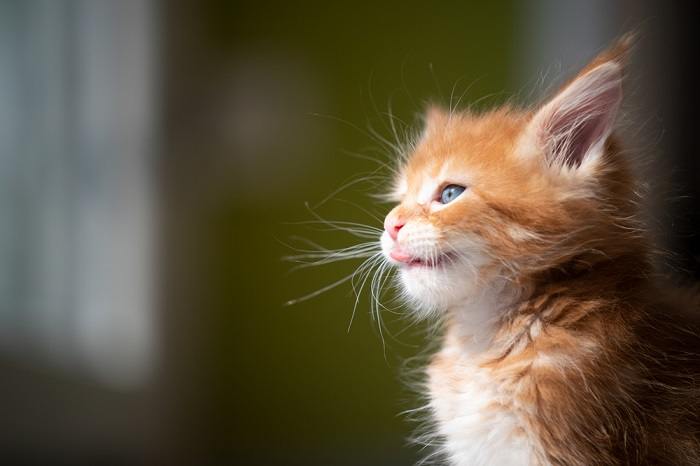
Cases of cerebellar hypoplasia need to have a restricted lifestyle but otherwise they may be able to have a normal life in many ways.
Kittens with cerebellar hypoplasia need some adjustments made to their homes.
- No outside access: these kittens need to be indoors as their lives would be at risk if going outside and encountering hazards or threats due to their poor mobility as they cannot jump or climb as normal cats can.
- Non-slip flooring: this helps with mobility
- Low-sided litter trays: these may be helpful as affected kittens may not be able to manage a normal litter box
- Low sided water bowls and food bowls: should be offered to allow independent access
Prevention of Cerebellar Hypoplasia
The main risk factor for cerebellar hypoplasia is infection of the mother or young kitten with feline panleukopenia virus. This is preventable through vaccination.
Conclusion
Cerebellar hypoplasia is a rare condition that affects some kittens from birth. Treatment is not usually possible, and while some mildly affected kittens may improve with time, affected animals usually need some sort of special care for their lifetimes.
Frequently Asked Questions
Can cats develop cerebellar hypoplasia at an older age?
Cerebellar hypoplasia is a developmental condition that happens while this part of the brain is developing (last three weeks of pregnancy and first three weeks of life) so it cannot develop in an older cat. It is, of course, possible that other types of cerebellar disease (e.g. tumors, hemorrhage) may rarely develop in cats at any age, causing similar signs of cerebellar malfunction.
How do you treat a cat with cerebellar hypoplasia?
No specific treatment is available but a cat’s lifestyle can be adapted so that their lack of coordination does not adversely affect their quality of life too seriously.
Are cats with cerebellar hypoplasia happy?
Depending on the severity of the condition, many affected cats have very happy lives.
Is cerebellar hypoplasia fatal in cats?
This is not a fatal problem, and it is not progressive.
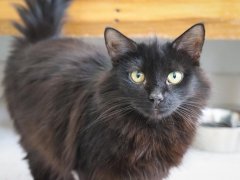




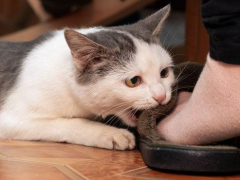

I do TNR and I have a lady i am helping with about 10-15 cats I just got introduced to. I went over the other day and she has a 5 month old kitten with cerebellar Hypoplasia sweet thing, Wobbly gets around ok eating ok, but she still has her out in the garage where the other cats come and go. I want her to take it inside it followers her everywhere. Any suggestions on how to care for this kitten, it is underweight. Mom and other kittens are all feral. Thank you
HI Sha,
Would be best to post your question here:
https://cats.com/community/health-care